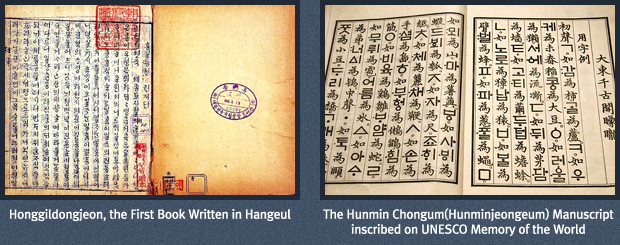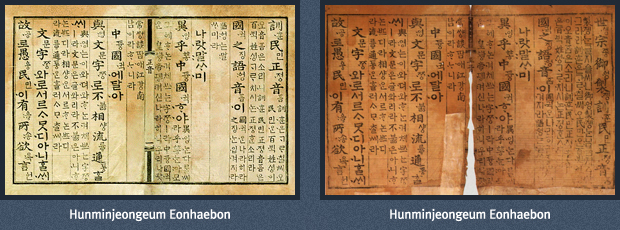|
|
|
|
|
|
|
| |
 |
here is a unique alphabet system in Korea that is incomparable to other languages. We call it, Hangeul. It has been as a transcribing means for the Korean language since it has been promulgated in 1446. Its long usage has been considered as a rudimental factor for Korean pride and spirit.
|
|
| |
 |
| |
 |
Before Hangeul was invented, Koreans used the Chinese characters to communicate. As Latin has been used throughout Europe in the Middle Ages, the Chinese characters have been widely used as a common language for in East Asia. But the difference between the speech and the alphabets has brought disparate between the two. This was because the Chinese characters were difficult to transcribe, causing people to have many difficulties in studying the Chinese characters. Although Seolchong from Silla Dynasty arranged Idu, a way of transcribing Chinese in Korean style, lack of basic understanding the Chinese characters hindered the people to use them in their daily life. Above all, farming was prioritized in those days, making it impossible for the commoners to study the characters while putting their work aside. |
| |
 |
|
Knowledge was power in those days, meaning literacy was connected directly to social vested rights. The hard lexicon system constituted of Chinese characters determined and fixed the social status. An illiterate could not even understand the questions on the civil service examinations. The application process for the examinations was obviously limited to the sons of high social status. Considering that the civil service examination was a gateway to enter the government service in those days, the Chinese characters and the Chinese writings were the suitable means for the noble to keep the hereditary succession of wealth and power. What is more, the difficulties in reading Chinese were a great burden for the commoners. It wasn’t unusual for the illiterate people who can’t even read their criminal charges to get arrested and falsely charged with the crime they have never committed. |
| |
 |
|
In 1443, the invention of an alphabet system itself consisting of 28 letters, was an epoch-making and unprecedented creation. King Sejong himself invented the Korean script or Hunminjeongeum for the illiterate people to settle their unfair charges by solving the aforementioned problems and to establish a more beautiful and better society for people by teaching them morals and knowledge. Hangeul, of which its striking excellence is acknowledged all over the world, is rooted on its wise and humanitarian intention. As a matter of fact, it was a revolution that the ability to decipher the structure of alphabets and the procurement of vested right limited to the noble class has been doled out to each individual. It is a surprise that King Sejong was in the center of this revolution as the leader of the privileged class. Despite the strong opposition of the Cabinet members of the court including Choe Manri, King Sejong distributed Hunminjeongeum tenaciously, convincing the Cabinet members with his scholar insight. King Sejong’s benevolence is respected and he is regarded as a sage king.
The adage written in Hunminjeongeum Haeryebon or the expounder says, the wise can understand in the forenoon, even the foolish can understand in ten days, meaning Hunminjeongeum is easy to learn. It goes without saying that simple and systematic Hangeul compared to broad and complex Chinese characters has contributed greatly to put an end to illiteracy. The peasants of the Middle Ages were able to read and write. The distribution of knowledge was the pride of Korea, exceeding the cultural standard set in the West. The peasants were able to realize social unification and the agricultural development as the books in Hangeul on faming and manners have become pervasive. The popularity of Korean novels led the prevalence of the publishing business and played the role of locomotive to leap forward to modernization from the medieval society.
|
| |
 |
| |
 |
|
All alphabets used in the world are classified into ideogram and phonogram. The Chinese characters are typical example of ideogram as each character has its own specific meaning. However, ideogram has a big shortcoming. It requires new characters as the number of materials and ideas increase in line with the social development. The inconvenience of memorizing new words has become inevitable when using the ideographic system. On the other hand, phonogram is a linguistic system that each character corresponds to a specific sound, making it easier for the speakers to manage abundant sounds of a language.
Phonogram can be subdivided into syllabic and phonemic alphabets. Syllabic alphabets, Japanese Kana characters as an example, consist of symbols for consonants and vowels such as ‘Ka’ and ‘Yeo’ that do not distinguish between the consonant and vowels. Roman alphabets and Hangeul are one of the phonemic alphabets that are more developed than the syllabic alphabets. Hangeul can express the sounds of the Korean language by combining initial sound, medial vowel and final consonant. This however, has been reduced to only 24 alphabets, displaying more economical and simple linguistic system than that of Chinese and Japanese.
Some scholars itemize feature alphabets as further more developed alphabet system. The feature alphabets separate one sound from another. Hangeul is sometimes classified feature alphabets. For instance, let’s take a look at the Korean alphabets, ‘ㅋ’ and ‘ㄲ.’ Both Hangeul are made based on ‘ㄱ.’ We can intuitively know that ‘ㅋ’ and ‘ㄲ’ are the alphabets which phonetic features (aspirate, fortis) are added by adding strokes to ‘ㄱ.’ In other words, Hangeul is classified into phonemic alphabets, however, it is linguistically better and takes more scientific approach.
Hangeul also has some noteworthy characteristics in its forming principle.
The first principle is the principle of simplicity. The basic formation of consonants and vowels of Hunminjeongeum pursuits extremely concise and minimal form. It is interesting that Hangeul can be structured with the basic figures consisting of triangle, circle, square, point and a straight line. The next is the principle of adding-stroke. All the cha racters of Hangeul are developed by simply adding strokes to basic characters for aspirate and fortis. In addition, basic forms are shaped in bisymmetric figures on their central axes. This bisymmetric structure offers a sense of balance and stability.
|
| |
 |
| |
 |
The systematic and simple system theory of Hangeul is applied much more usefully today. Hangeul is the optimal alphabet for sending text messages and documenting by using electronic word process in an information-oriented era. Hangeul is easiest to work with on a 12-button cell phone keypad and 60-button computer keyboard. It is especially useful when making a 12-button cell phone keypad for sending text messages. Either Cheonjiin or the stroke-adding system, all the keyboard layouts used domestically is devised on an extension of the invention principle of Hangeul. Thanks to its facile formation principle, Hangeul excels both Chinese characters and Japanese Kana in efficiency. Seeing the broadcasting programs featuring the foreign immigrants in Korea, they often are surprised by the convenience of using Hangeul cell phone keypad.
We are now living in the era where design has become crucial. Hangeul follows a bound-writing character system like Chinese characters, however, unbound-writing system can also be applied like Japanese Kana and alphabets in the West. Moreover, it can be written in both horizontal and vertical ways, offering abundant ideas to design the beauty of the Hangeul. Hangeul design, currently boasting its dynamic uniqueness in language, displays its properties in tandem with the design.
|
| |
 |
|
As stated above, Hangeul’s beauty and scientific approach to the language are more than enough to draw people’s attention. That would be why Hangeul has been used constantly for a long time in Korea. In 2008, Korea celebrated the 562nd birthday of distribution of Hangeul. Hangeul Day which falls on October 9 has become more thriving and diversified each year, meaning the interest in Hangeul by Korean is on the rise. Products on Hangeul are launched and people are making efforts to use Hangeul correctly from far and near. By learning more on Hangeul, you can understand and take a step closer towards Korea and Koreans. As you already know, Koreans can’t live a day without Hangeul. |
|
|
|
|
